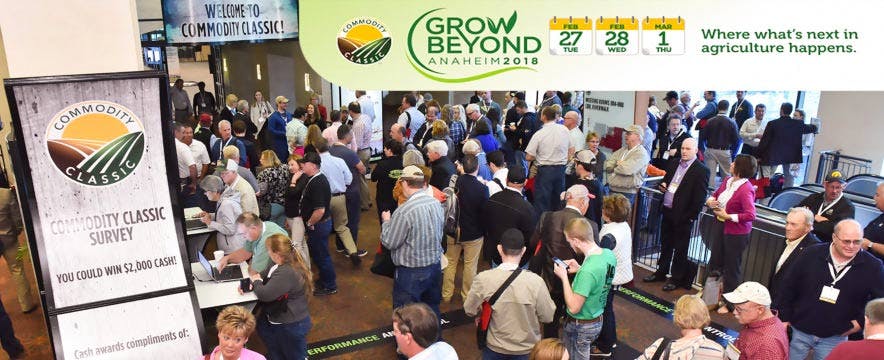Future of Agricultural Trade a Hot Topic at 2018 Commodity Classic
The upcoming farm bill debate, NAFTA and the future of agricultural trade were top of mind for producers who visited the USMEF booth at the 2018 Commodity Classic last week in Anaheim, California.
An annual convention organized by the National Corn Growers Association, American Soybean Association, National Association of Wheat Growers and National Sorghum Producers, the trade show attracts thousands of grain farmers and ag industry leaders from across the United States.
USMEF’s booth on the trade show floor served as a reminder of the connection between red meat exports and demand for corn and soybeans, with USMEF past chair Bruce Schmoll and USMEF Executive Committee member Dean Meyer greeting visitors and answering questions about U.S. beef, pork and lamb exports.
“Each year at Commodity Classic we talk to producers who are not fully aware of the value red meat exports have for the U.S. grain industry, so it’s nice to have those discussions and help spread the word,” said Schmoll, a corn and soybean producer from Claremont, Minnesota. “To be able to show corn and soybean farmers the real numbers meat exports add to the oilseed and feedgrain industries is rewarding. It demonstrates how closely tied the grain and livestock sectors really are.”

USMEF past chair Bruce Schmoll (second from left) and USMEF Executive Committee member Dean Meyer (third from left) answer questions from visitors to the USMEF booth at Commodity Classic
Meyer, who grows corn and soybeans and raises cattle in Rock Rapids, Iowa, represents the feedgrain producing sector on the USMEF Executive Committee. He said trade agreements with various international customers of U.S. red meat were of particular interest at this year’s Commodity Classic.
“Many who came to our booth wanted to talk about NAFTA and the Trans-Pacific Partnership, and were curious about how changes in NAFTA and other trade agreements may effect U.S. beef and pork exports, which in turn influence the feedgrain sector,” said Meyer. “It shows that people are making an effort to become more educated on trade and how important it is to U.S. agriculture. Questions during the show ranged from U.S. beef in China and Japan to U.S. pork exports to Mexico and South America.”
U.S. Secretary of Agriculture Sonny Perdue was the keynote speaker at Commodity Classic’s opening general session, focusing mainly on NAFTA and the farm bill.
Philip Seng, USMEF CEO emeritus, joined Schmoll and Meyer at the USMEF booth and took part in several media interviews focused on agricultural trade.
“There is certainly a keen awareness of what is going on with trade and the impact it has on the U.S. agricultural industry,” said Seng. “That is actually a positive thing – the fact that more producers and people working in ag are aware of what is at stake. The ag economy is greatly impacted by international trade, so the concern is certainly warranted.”

USMEF CEO Emeritus Philip Seng was interviewed by many reporters covering Commodity Classic
Some of the questions asked at the USMEF booth were born out of the buzz created by Jayson Lusk, head of the Agricultural Economics Department at Purdue University. Lusk was a speaker at the Bayer AgVocacy Forum in Anaheim the day before Commodity Classic opened. His speech included a reference to the need for the U.S. to export more meat.
“The U.S. is not likely to see a big increase in meat demand, so if there’s any growth it will be internationally,” Lusk said during his presentation. He also noted technological advances in traceability and predicated that the entry of companies like Amazon into the global food market will raise expectations about traceability.
USMEF Assistant Vice President for Industry Relations John Hinners said this year’s Commodity Classic served as a sort of reunion for corn and soybean producers who have participated in international trade missions with USMEF.
“We had well over 20 USMEF Heartland Team alumni stop by the booth during the show to say hello and visit about their market observations and friendships they have made with USMEF staff and other trade team members while traveling to international markets,” said Hinners. “To a person, they all relayed how much they appreciate what they learned about those markets and about how USMEF works on behalf of producers here at home leveraging their promotion dollars to drive record exports of value-added red meat products. Even in uncertain times, the attitude of everyone who stopped by the USMEF booth was exceptionally positive as they look at the long-term benefits of trade.”
USMEF also sponsored a luncheon during Commodity Classic to thank the corn and soybean industry for its partnerships and contributions to the organization. Schmoll presented an overview of USMEF’s efforts to grow U.S. red meat exports to more than 100 luncheon attendees.

An estimated 10,000 producers, agriculture leaders and representatives of agriculture businesses attended this year’s Commodity Classic in Anaheim, California
